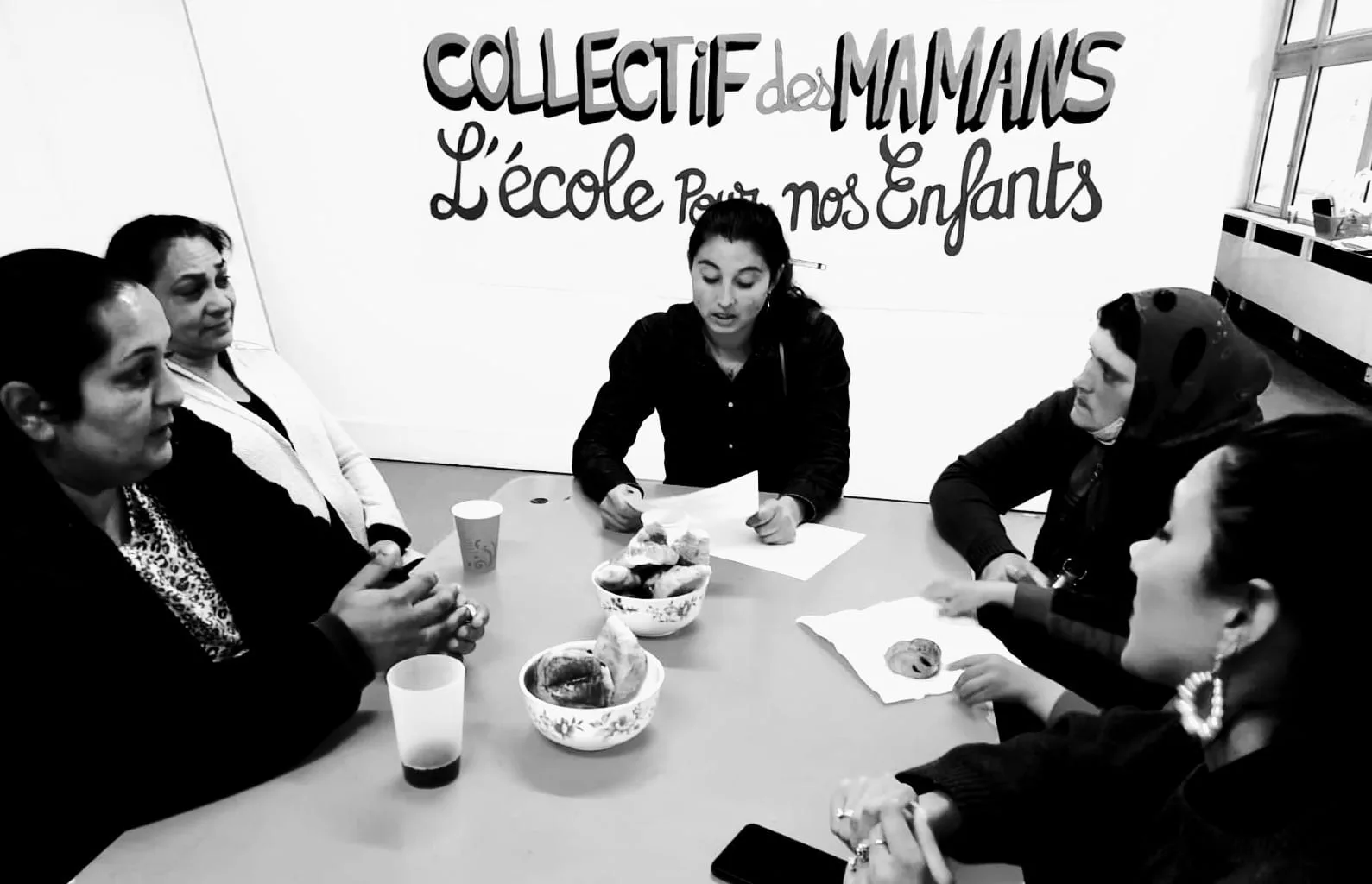Battle story
The battlefield is the hearts of the people
By Pierre Chopinaud
(Previously…)
The target wouldn’t be all the mayors, nor the minister, it would be in the middle, at the right height: it would be the academy rector. There, the machine comes to life. The problem is that there is no Godzilla, there is no Joker, the person is in the presence of the speaker of Him, all of this is not fair to the person. Mirela, Alisa, Emmanuelle and Lucie printed a photo of him, investigated his career, guessed his values: they portrayed his character. That’s it, the casting was complete: the collective of mothers was going to be able to train for combat and go on the attack…
“The first tactical challenge consisted of inventing a stratagem by which we would make the invisible visible: to constitute the proof”
Alisa, Mirella, Lucile, and Emmanuelle were ready for the first major episode of the film, in which the mothers’ collective would be the heroines, for the implementation of their first tactic, the first battle, the first action. And just like actors who are about to play a scene or soldiers who are about to go into combat, they began, with my help, with training, rehearsals, and simulations.
The first tactic was to seek out evidence of discriminatory refusals of school enrollment. However, if public structures know how to discriminate methodically, they also know how to structurally make discrimination invisible. The first tactical challenge consisted of inventing a stratagem by which we would make the invisible visible: to constitute the proof. We therefore developed a protocol that consisted of everything that a mother-soldier-actress should say—and in what order—when she went to the town hall to register her child for school. Not only what she should do and say, but also what to have her interlocutor do and say. So we wrote a scene with dialogue that varied depending on the attitude of the municipal employee: each mother had to know her role by heart and above all: each mother had to start the recorder on her phone upon entering in order to capture the violation of the law of which the institution through its agents was guilty, but also the discriminatory, racist and insulting words which constitute, in the world as it is, the way in which society addresses these mothers and their children on a daily basis.
“It was therefore a question of pushing one’s own vulnerability, one’s own weakness, to the extreme, to the point of caricature, in order to transform it into strength and, by this subterfuge, to push the adversary into error”
Once the plan was established, they practiced in Askola’s small training vans, converted into training rooms, by role-playing: one played the mother, the other the municipal employee, until each had mastered their lines, their role, and the attitude to adopt depending on the opponent’s reactions, enough to confidently go into “battle”: the hunt for evidence. We knew that if the leading members, namely Mirela and Alisa, went into a duel against the municipal officials, we had a good chance of losing. Of course, they had more experience, self-confidence, and self-belief. But since they worked as school mediators on a daily basis, they were easily identified by the municipal officials. The latter would be wary and not be fooled by the plan. They all decided together that the new members would be the ones to go to the front. When a woman calls the Askola association to enroll her child in school, it’s an “anonymous” member of the mothers’ collective who accompanies her to register. But beneath her anonymity, she hides her mastery as an actress, a soldier, and an activist.
One of the instructions they received was to overplay not only this anonymity, but above all the stereotypical image that municipal agents have of mothers living in slums. They had to appear naive, vulnerable, exaggerate their difficulty understanding French and expressing themselves. In this way, the adversary would be confident, would experience their power and sense of domination to excess, and would unsuspectingly surrender to the usual humiliations and discrimination. It would therefore be a matter of pushing their own vulnerability, their own weakness, to the extreme, to the point of caricature, in order to transform it into strength and, through this subterfuge, to push the adversary into error, and obtain from them the weapons—the evidence—with which they would be defeated
“It was victory after victory, throughout the autumn: each time the offensive refusal was transformed into a weapon which was turned, not only against the municipal agent, but against all his superiors, up to the mayor of the city, who was ultimately the culprit”
And it was victory after victory throughout the fall: each time, the offensive refusal was transformed into a weapon that was used, not only against the municipal official, but against all his superiors, all the way up to the mayor, who was ultimately the culprit. Each time, the duel turned in favor of the mother, who obtained a speedy enrollment in school, thanks to the sword of Damocles that the collective held over the entire municipal service. Far from the front lines, “in the rear,” behind the keyboard of her computer or the micro-phone, Lucile played her part, issuing the threat: “We have proof of your violation of the law. You illegally refused to enroll a child in school for racist reasons. We will take this to court and notify the press if you don’t comply!”
The mothers, gathered together in an organized collective, had, from this first action, forged the sword which would make the Caesars of the department tremble, and which would soon, as we shall see, make even the office of the Minister of Education tremble.
But back to the present: if the sword of Damocles weren’t enough, the mothers’ collective carried out the threat, and Maîtres Ciuciu, Crusoe, and Stoffaneller, the allied lawyers, took action. The law was on the mothers’ side. The bad guys were losing every time. It was checkmate on all sides. Beyond these first duels won, these small victories that were strung together like pearls on the organization’s necklace of glory, each time it was just as much evidence that fell into the bag in preparation for the first major public action, the launch of the great drama in which the mothers would publicly ask the big bad rector to pay the price for the offense done to their children.
“the spectacle of pride and courage that replace fear and resignation in hearts. That is, the birth of shared faith that unites the offended into a single choir”
It was then that I began to receive, as an organizer, the greatest reward after all the effort: the spectacle of pride and courage replacing fear and resignation in hearts. That is, the birth of a shared faith that unites the offended in a single choir. I am not religious, but I know that this is the moment shared by Christians, for example, on Easter night when the light is shared among all, through candles, from flame to flame. Making the invisible visible isn’t just about capturing the evidence. It’s about seeing what makes women and men human come alive: the certainty that justice comes, not by chance, but through action. After years of experiencing humiliation, not only as a mother guilty of belonging to a despised group and who sees her child’s life degraded, humiliated, but also as a social worker who can’t change anything, despite the law, despite morality, despite everyone being taught since they were little that all children’s lives are equal… After years of sadness and resignation, fear was beginning to change sides. The last were replacing the first, justice was near.
“How can you do this to the mayor, who is such a good person? The “this” in question was simply the power to enforce a Roma child’s right to school and to impose that his life has the same value as the lives of the children of the important lady who is crying. Fear had changed sides ”
I knew it with certainty, as one knows that spring is coming by seeing the flowers bloom, when Lucile, Emmanuelle, and Mirela told me about an appointment they had, after a mother’s bitter fight at the checkout with the mayor’s office of a large city in the department. Just a month ago, these “important” men and women were the ones throwing rocks at the mothers and children who were pacing, from the shantytown, the mountain that is, for them, the path to school. Now, the girls were sitting at the top facing them. They were looking them straight in the eyes because it was they who were now holding a rock—the court’s condemnation, the public shame—above their heads. That day, one of these important figures, faced with the intransigence of the leaders of the mothers’ collective who were demanding the immediate enrollment of a child in school, left the room crying with helplessness: “How can you do this to us? How can you do this to the mayor who is such a good person?” The “it” in question was simply the power to enforce the right to school of a Roma child and to impose that his life has the same value as the lives of the children of the important woman who was crying. Fear had changed sides.
(More in the next episode….)

